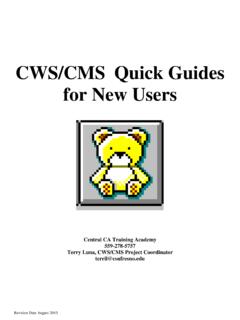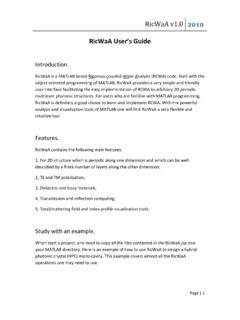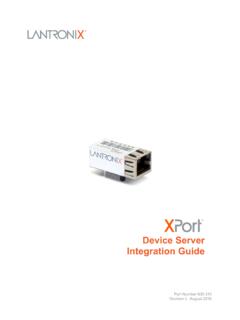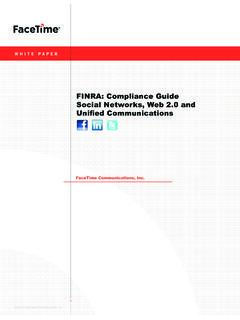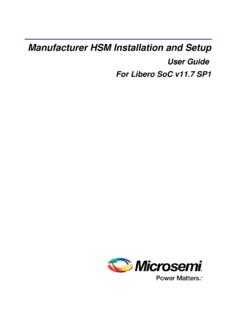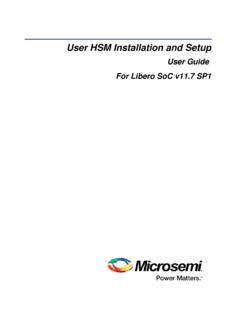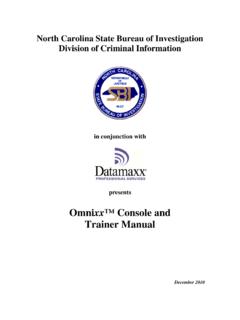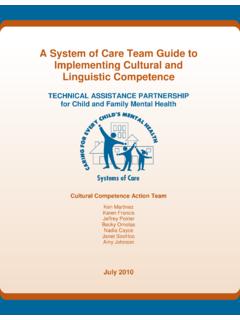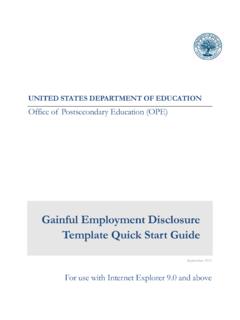Transcription of CC Debugger User's Guide (Rev. H) - TI.com
1 CC DebuggerUser's GuideLiteratureNumber:SWRU197 HSeptember2010 the CC CC Debuggerto the CC Debuggerto a CC Debuggerto a CC Debuggerto a CC FirmwareAutomaticallyin FirmwareManuallyin CC ContentsSWRU197H September2010 RevisedApril2014 SubmitDocumentationFeedbackCopyright 2010 2014, of TargetConnectorPinson CC Debuggingof SoCto DebuggerConnectedto DebuggerConnectedto CC112x/CC1175 DebuggerConnectedto CC110x/CC11 DebuggerConnectedto ManuallyUpdatingthe CC Bootloaderon the CC DebuggerUsingAnotherCC Bootloaderon the CC Updatingthe of Tables1 SupportedSPI Connections(markedOK).
2 102 USARTPin Out September2010 RevisedApril2014 List of FiguresSubmitDocumentationFeedbackCopyri ght 2010 2014,TexasInstrumentsIncorporatedUser's GuideSWRU197H September2010 RevisedApril2014CC Debugger1 IntroductionThe CC Debuggeris primarilyusedfor Flashprogrammingand debuggingsoftwarerunningon CCxxxx8051-basedSystem-on- chip (SoC) PC toolsavailablefor thesepurposesare the SmartRF FlashProgrammer[9] fromTexasInstrumentsand IAR EmbeddedWorkbench for 8051fromIAR Systems[15].Whenconnectedto the Debugger ,the SoCdevicescan be controlleddirectlyfromSmartRF Studio[8].SmartRFStudiois also able to controlsupportedCCxxxxRF transceivers(CC2520,CC2500,CC110x,CC11xL ,CC112x,CC120x)whenthey are connectedto the debuggeras explainedin addition,the CC Debuggeris usedfor configuringthe CC85xxdeviceswith the PurePathWirelessConfigurator[12] and controllingthemwith the PurePathWirelessCommander[13].
3 SmartRFis a trademarkof EmbeddedWorkbenchis a registeredtrademarkof IAR a registeredtrademarkof MicrosoftCorporationin the UnitedStatesand a registeredtrademarkof MicrosoftCorporationin the UnitedStatesand/orothercountries,or a registeredtrademarkof Windowsis a registeredtrademarkof MicrosoftCorporationin the UnitedStatesand othertrademarksare the propertyof DebuggerSWRU197H September2010 RevisedApril2014 SubmitDocumentationFeedbackCopyright 2010 2014, Acronyms2 Abbreviationsand AcronymsCSnChipSelect(activelow)DCDebugC lockDDDebugDataDUTD eviceUnderTestGNDG roundLEDL ightEmittingDiodeMISOM asterIn SlaveOutMOSIM asterOut SlaveInRFRadioFrequencySCLKS erialClockSoCSystem-on-ChipSPIS erialPeripheralInterfaceUSBU niversalSerialBusVDDP ositivevoltageon target3 Box Contents 1 x CC Debugger 1 x USB-Ato Mini-BUSB cable 1 x 10-pinflat cablewith 2x5 connector 1 x 10-pinflat cablewith 2x5 connector 1 x connector Documentation4 OperatingConditionsof the CC VOperatingtemperature:0 C to 85 CRegulatedvoltageon CC VMaximumtargetcurrent:(1)200 mA(1)Microsoft Windows 2000operatingSupportedOperatingSystems.
4 SystemWindowsXP SP2/SP3operatingsystem(32-bitversions)Wi ndowsVista operatingsystem(32 and 64 bit)Windows7 operatingsystem(32 and 64 bit)Windows8 operatingsystem(32 and 64 bit)(1)Onlyapplicableif the targetis poweredfromthe CC September2010 RevisedApril2014CC DebuggerSubmitDocumentationFeedbackCopyr ight 2010 2014, USBD riverTo get the requiredUSBdriverfor the CC Debugger ,it is necessaryto installone of the toolslistedbelow: SmartRFStudio[8] SmartRFFlashProgrammer[9] SmartRFPacketSniffer[10] PurePathWirelessConfigurator[12] PurePathWirelessCommander[13]Alternative ly,you can downloadCebal CCxxxxDevelopmentToolsUSBD riverfor Windowsx86 andx64[4], whichis a standaloneinstallerincludingonly the driveris installed,connectthe CC Debuggerto the PC.
5 The USBdriveris can quicklycheckthat the debuggerhas beenassociatedcorrectlywith the USBdevicedriverbyopeningthe debuggershouldappearas a Cebalcontrolleddevice .Figure1. VerifyCorrectDriverInstallationFor furtherdetailsor troubleshootingthe driverinstallationprocess,see theCebal CCxxxxDevelopmentToolsUSBD riverInstallationGuide[5]. ToolsCurrently,the CC Debuggercan be usedtogetherwith the followingPC Tools: IAR EmbeddedWorkbenchfor 8051: In circuitdebuggingof system -on-chips SmartRFFlashProgrammer: Flashprogrammingof system -on-chips SmartRFStudio: RF testingof radiodevices(transceiversand SoCs) SmartRFPacketSniffer: Packetsniffingwith selectedradiodevices PurePathWirelessConfigurator: Programmingof CC85xxdevices PurePathWirelessCommander.
6 Advancedcontrolof CC85xxdevicesThe debuggeroperatesas the interfacebetweenthe RF deviceand the thecorrectconnectionis madebetweenthe deviceand CC Debuggerbeforestartingto use the connectionof the deviceto the CC Debuggeris coveredin DebuggerSWRU197H September2010 RevisedApril2014 SubmitDocumentationFeedbackCopyright 2010 2014,TexasInstrumentsIncorporatedPin 1 Pin 2 Pin 1 Pin CC Debuggerto the Device6 Connectingthe CC Debuggerto the targetconnector,locatedon the lateralside of the Debugger ,is a 10-pin2x5 pitchconnectorwith a (male)surfacemountedheaderswouldbe95278- 101A10 LFfromFCI or Placementof TargetConnectorPinsThe adapterboard,whichhas a 10-pin2x5 pitchconnector,has the samepin (male)surfacemountedheaderswouldbe 20021121-000-10C4 LFfromFCI or Placementof TargetConnectorPinson AdapterBoardThe pin-outof the targetconnectoris shownin Figure4.
7 Notethat not all of thesepins needto beconnectedto the targetdevicefor programmingand ,GND,DD, DC and RESET arerequiredfor the otherpins are optionalor for September2010 RevisedApril2014CC DebuggerSubmitDocumentationFeedbackCopyr ight 2010 2014,TexasInstrumentsIncorporatedUSBC ontrollerLevelConverterVdd fromtargetVdd (local)CC DebuggerTARGETT argetConnector21436587109 GNDDC (Debug Clock)Csn (SPI chip Select) (from Debugger )Target Voltage SenseDD (Debug Data)SCLK (SPI Clock)MOSI (SPI Data Out)MISO (SPI Data In)Connectingthe CC Debuggerto the TargetConnectorPin-OutNotethe conceptwith the signalis usedby the levelconverterson theCC Debuggerto handledifferentvoltagelevelson the targetboardand the 2 on the targetconnectormustbe connectedto VDDon the VoltageFromTargetto CC DebuggerAlternatively,it is possibleto powerthe targetby connectingpin 9 to VDDon the that case,theCC V to the CC Debuggerto a DebuggingFor successfuldebuggingof a TI 8051-basedRF SoC,connectthe two debugsignalsDebugData(DD)and DebugClock(DC)
8 And the resetsignalRESETnto the DD is a addition,the CC Debuggermustbe connectedto GNDand VDDon the usedas an inputto the levelshifterson the CC Debugger ,thus allowinga differentoperatingvoltageon the targetthaninternallyon the CC111x,CC251x,CC243x,CC253xand CC254x,exceptCC2544and CC2545,connectthe DDsignalto pin DC to pin CC2544,connectthe DD signalto DC to CC2545,connectthe DD signalto DC to it is possibleto powerthe targetboardfromthe debuggerby connectingthe V signalon pin9 on the connectorto the DebuggerSWRU197H September2010 RevisedApril2014 SubmitDocumentationFeedbackCopyright 2010 2014,TexasInstrumentsIncorporated2143658 7109 GNDDC (Debug Clock)RESETnDD (Debug Data) DebuggerConnectorCCxxxxSystem-on-ChipNOT E 2 VddNOTE 110 k k 1 V from optionally beused to power thetarget CC Debuggerto the DeviceFigure6.
9 MinimumConnectionfor Debuggingof 8051 SoCNOTE:Someearlyrevisionsof certainSoCs(CC2430,CC2510and CC1110)neededan externalpull-upto avoidunwantedtransitionson the debugclockline duringchip reset,inadvertentlysettingthe devicein new revisionsof all SoCsnow havean internalpull-upon ,so this externalcomponentis not :The RESET npin is sensitiveto noiseand can causeunintendedresetof the resetlinessusceptibleto noise,it is recommendedto add an externalRC recommendedRESET circuitry,see the device-specificSoCdatasheetand CCDebuggersupportsslowtransitionson the resetline, usinga 2 ms delaybetweenanytransitionon the RESET line and othertransitionson the DC and DD SmartRFStudioUse the sameconnectionas for debuggingthe September2010 RevisedApril2014CC DebuggerSubmitDocumentationFeedbackCopyr ight 2010 2014,TexasInstrumentsIncorporated2143658 7109 GNDDC (Debug Clock)RESETnDD (Debug Data)
10 K 1 V from optionally beused to power thetarget boardConnectingthe CC Debuggerto the SmartRFPacketSnifferIn orderto use the packetsniffercapabilitiesof the CC Debugger ,it is also necessaryto connectthe SPIbus to the SPI interfaceis usedby the CC Debuggerfor readingthe capturedRF packetsfromthe SoC(seeFigure7).Figure7. Connectionto SoCto EnablePacketSniffingNotethat the packetsnifferoverwritesthe Flashon the SoCwith SPI interfaceto the SoCusedfor packetsniffingAll of the currentTI RF SoCscan be configuredto operateas SPI slaves,with the SPI signals(CS,SCLK,MISOand MOSI)goingto one of the packetsnifferapplicationprogramstheSoCwi th firmwarethat configuresone of the USART peripheralsin orderto communicatewith the firmwarecan use any of the four possiblepin configurations(USART0 or 1, pin outalternative1 or 2).










